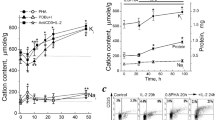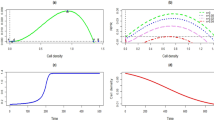Abstract
THE division of most “normal” cells in culture is inhibited after they have grown to a confluent monolayer. This is not the case with cells transformed either spontaneously or by tumour viruses1. Alterations of the surface membrane might be partly responsible for this uncontrolled growth2: for example, protease action at the surface of contact-inhibited cells causes them to divide3,4 and acquire surface properties characteristic of malignant cells, such as increased agglutinability by plant lectins5,6. Neuraminidase7 and hyaluronidase8 can also initiate division of contact-inhibited cells. Transformed cells contain abnormally large concentrations of proteases and glycosidases9,10 which are presumed to be lysosomal enzymes. Since cortisol stabilizes lysosomal membranes11, we decided to investigate its effect on the growth of cells not subject to density inhibition of division: we found very little effect on 3T6, L, polyoma-transformed 3T3 (Py3T3) and SV40-trans-formed 3T3 (SV3T3) cells. However, cortisol unexpectedly stimulated DNA synthesis and division of density-inhibited 3T3 cells. This stimulation was specific for cells subject to contact inhibition of division. Density-inhibited early passage diploid human foreskin fibroblasts (HF cells) were similarly stimulated by cortisol. In addition, the stimulation was specific for steroids with high levels of glucocorticoid activity. The stimulation appears to involve changes in the cell surface, for treated 3T3 cells were agglutinated to a greater degree by concanavalin A than control cells.
This is a preview of subscription content, access via your institution
Access options
Subscribe to this journal
Receive 51 print issues and online access
$199.00 per year
only $3.90 per issue
Buy this article
- Purchase on Springer Link
- Instant access to full article PDF
Prices may be subject to local taxes which are calculated during checkout
Similar content being viewed by others

References
Todaro, G. J., Green, H., and Goldberg, B., Proc. US Nat. Acad. Sci., 51, 66 (1964).
Burger, M. M., Current Topics in Cellular Regulation, 3, 135 (1971).
Burger, M. M., Nature, 227, 170 (1970).
Sefton, B. M., and Rubin, H., Nature, 227, 843 (1970).
Burger, M. M., Proc. US Nat. Acad. Sci., 62, 994 (1969).
Inbar, M., and Sachs, L., Proc. US Nat. Acad. Sci., 63, 1418 (1969).
Vaheri, A., Ruoslahti, E., and Nordling, S., Nature New Biology, 238, 211 (1972).
Vasiliev, J. M., Gelfand, I. M., Guelstein, V. I., and Fetisova, E. K., J. Cell. Physiol., 75, 305 (1970).
Bosmann, H. B., Exp. Cell. Res., 54, 217 (1969).
Bosmann, H. B., Biochim. Biophys. Acta, 264, 339 (1972).
Weissman, G., and Thomas, L., Rec. Prog. Hormone Res., 20, 215 (1964).
Cunningham, D. D., J. Biol. Chem., 247, 2464 (1972).
Nordone, R. M., Todd, J., Gonzales, P., and Gaffney, E. V., Science, 149, 1100 (1965).
Ozanne, B., and Sambrook, J., The Biology of Oncogenic Viruses (edit. by Silvestri, L. G.) (North-Holland, Amsterdam, 1971).
Cantarow, A., and Trumper, M., in Clinical Biochemistry (Saunders, Philadelphia, 1962).
Burger, M. M., Bombik, B. M., Breckenridge, B. M., and Sheppard, J. R., Nature New Biology, 239, 161 (1972).
Ballard, P. L., and Tomkins, G. M., Nature, 224, 344 (1969).
Salvato, J., and Melnykouych, G., In Vitro, 7, 247 (1972).
Doughtery, T. E., and White, A., Amer. J. Anat., 77, 81 (1945).
Pratt, W. B., and Aronow, L., J. Biol. Chem., 241, 5244 (1966).
Schimke, R. T., Sweeney, E. W., and Berlin, C. M., J. Biol. Chem., 240, 322 (1965).
Rosenau, W., Baxter, J. D., Rousseau, G. G., and Tomkins, G. M., Nature New Biology, 237, 20 (1972).
Pratt, W. B., and Ishii, D. N., Biochemistry, 11, 1401 (1972).
Baxter, J. D., and Tomkins, G. M., Proc. US Nat. Acad. Sci., 68, 932 (1971).
Schiller, S., and Dorfman, A., Endocrinology, 60, 376 (1957).
Cantor, C. W., and Prince, R. K., Biochim. Biophys. Acta, 83, 165 (1964).
Hamerman, D., Todaro, G. J., and Green, H., Biochim. Biophys. Acta, 101, 343 (1965).
Author information
Authors and Affiliations
Rights and permissions
About this article
Cite this article
THRASH, C., CUNNINGHAM, D. Stimulation of Division of Density Inhibited Fibroblasts Glucocorticoids. Nature 242, 399–401 (1973). https://doi.org/10.1038/242399a0
Received:
Issue Date:
DOI: https://doi.org/10.1038/242399a0
This article is cited by
-
Effect of Preoperative Single-Dose Corticosteroid Administration on Postoperative Morbidity Following Esophagectomy
Journal of Gastrointestinal Surgery (2010)
-
Effect of Prednisolone on Local and Systemic Response in Laparoscopic vs. Open Colon Surgery
Diseases of the Colon & Rectum (2009)
-
Effects of prednisolone and butyrate on agglutinability of HeLa cells by concanavalin A
Experientia (1983)
-
Effects of angiotensin II and of an angiotensin II receptor antagonist on Simian virus 40-induced tumor growth in vivo
Experientia (1980)
Comments
By submitting a comment you agree to abide by our Terms and Community Guidelines. If you find something abusive or that does not comply with our terms or guidelines please flag it as inappropriate.


